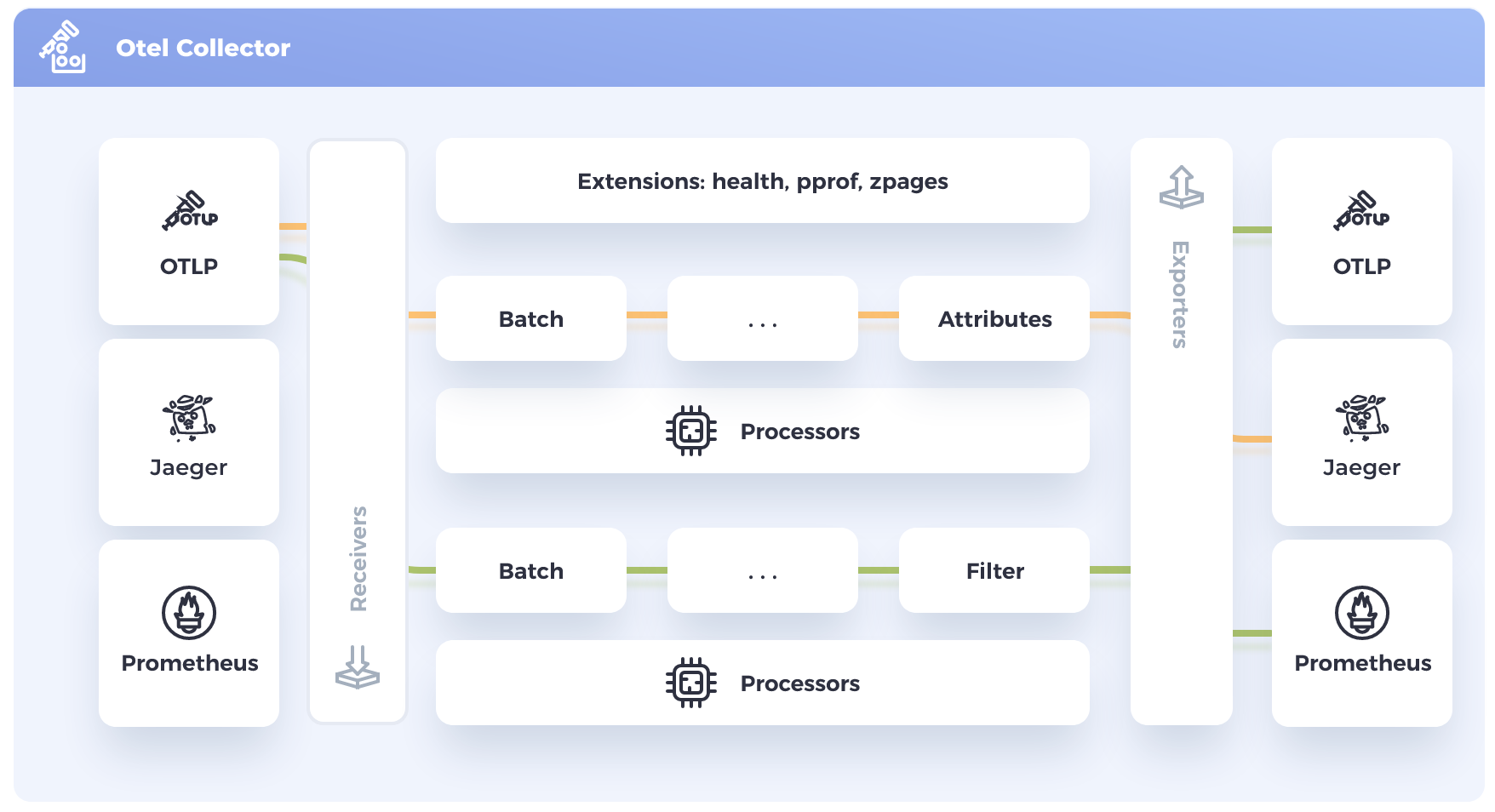OpenTelemetry Collector
What is the OpenTelemetry Collector
The OpenTelemetry Collector manages the reception, processing, and export of telemetry data, serving as a central hub for efficient data flow between instrumented applications and designated backends.
Here is a common setup which includes receivers, processors and exporters:
The setup operates as a structured pipeline with key components in the OpenTelemetry Collector.
Receivers
The initial stage involves Receivers, which can handle data in various protocols such as Prometheus (for time series data), Jaeger (for distributed tracing of user requests), and OTLP.
Processors
In the middle of the pipeline are the processors, responsible for manipulating and enriching data before exporting it to the destination. With 25 processors currently available, functionalities include batch (for data compression), memory_limiter (for memory management), filtering (to remove unnecessary logs), resource detection (for obtaining information from the host), and Kubernetes attributes processing (for automatically discovering and extracting metadata from Kubernetes resources). A combination of transform and attributes processors is employed for redacting sensitive data.
Exporters
At the final stage, exporters come into play, tasked with sending data to specific backends. With almost 50 exporters available, the choice often depends on your backend requirements.
Shipping OpenTelemetry data to FusionReactor Cloud
Shipping OpenTelemetry data to FusionReactor Cloud from FusionReactorAPM on Vimeo.
Step 1: Create an otel-config.yaml file
For our OTel Collector we need to create an otel-config.yaml file.
Tip
Be careful with the indentation here as yaml syntax is very sensitive.
receivers:
otlp:
exporters:
otlphttp:
endpoint: "https://api.fusionreactor.io"
compression: none
headers:
authorization: "<your api key>"
prometheusremotewrite:
endpoint: "https://api.fusionreactor.io/v1/metrics"
headers:
authorization: "<your api key>"
service:
pipelines:
metrics:
receivers: [otlp]
exporters: [prometheusremotewrite]
traces:
receivers: [otlp]
exporters: [otlphttp]
The receivers section declares that all telemetry data will be sent to the OTel collector's receiver that is running on otelcollector port 4318, using OpenTelemetry Protocol (OTLP) and HTTP format.
Tip
You can use gRPC instead of HTTP.
Step 2: Configure OTLPHTTP and Prometheus remote_write
Next we configure our OTLPHTTP exporter for traces, and the Prometheus remote_write for metrics. The collector sends the metric and tracing data to the endpoints - the FusionReactor Cloud - at the address api.fusionreactor.io.
Step 3: Replace credentials with API key
Replace both credentials under authorization here with your own API key.
Tip
To generate a new API key, go to FusionReactor Cloud > Account Settings > API Keys > Generate. Copy this key and paste it under credentials.
Step 4: Services outlined and data shipped
Finally, in the services section is where we bring everything together.
pipelines:
metrics:
receivers: [otlp]
exporters: [prometheusremotewrite]
traces:
receivers: [otlp]
exporters: [otlphttp]
-
Metrics and traces will be received by the OTLP receiver.
-
Metrics are then exported via Prometheus remote_write.
-
Traces are exported via the OTLPHTTP exporter.
All of the data is then shipped to the FusionReactor Cloud.
Step 5: Create OTel Docker image
Use this config file to create an OTel Docker image and input the following:
ADD otel-config.yaml /etc/otelcol/config.yaml
Step 6: Create docker-compose.yml file
Create a docker-compose.yml file with the following to start your Go App and your OTel Collector.
services:
gooteldemo:
image: gooteldemo
environment:
- OTEL_SERVICE_NAME=gooteldemo
- OTEL_RESOURCE_ATTRIBUTES="application=gooteldemo"
#otel
otelcollector:
image: gootelcollector
ports:
- "4318:4318"
- "8888:8888"
Step 7: Run “docker-compose up”
Run “docker-compose up” in the terminal to bring up your containers, starting my Go App and Telemetry collection.
Need more help?
Contact support in the chat bubble and let us know how we can assist.
Learn more
